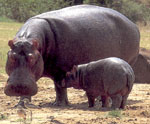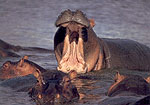HIPPOPOTAMUS


How to Recognize
Hippos are huge and bloated (males weigh up to 7,000 pounds!) with short legs, massive heads, and broad snouts. They are shiny gray in color with pink highlights. Their jaws contain sharp, 20-inch tucks and can open 150-degrees. They can chop a crocodile in half!
Hippos are frequently aggressive and extremely dangerous on land when threatened. They kill many people each year, usually when someone inadvertently blocks their path to the water. Another reason to not get too close is that hippos mark their territories and grazing trails by spraying dung and waving their tail at the same time which spreads it all over the place. Yuck!
Habitat
Hippos are found widespread and close to fresh water. They like slow-flowing rivers, dams, and lakes with pools, shallow banks, and adjoining grassland.
A hippo’s skin is very thin with no sweat glands which means it can rapidly dehydrate and overheat. Therefore, they spend most of the day submerged in the water with only their eyes, ears, and nostrils breaking the surface. A hippo can stay submerged under water for five minutes. They sigh when they surface to exhale. They emerge at night following well-worn trails to graze on land, travelling up to 18 miles in one night!
Behavior
Principally nocturnal. Bulls are solitary. Family groups consist of a dominate male matriarch with 10-15 females and their young. They tolerate close contact in the water but forage singly when on land. Males enlarge puddles to make temporary water holes in the rainy season. A large number of hippos congregate during the dry season. Cows with young babies are aggressive to other individuals.
Adult bulls defend territories against each other aggressively and most males bear these scars which makes it convenient to distinguish the males from the females. Hippos “yawn” when challenged, and territorial males shower each other with urine and feces as a sign of respect. Males, spaced apart in territories, advertise their dominance with loud and repeated wheezy honks.
Very funny to hear!
Breeding
Mostly during the rainy season, a single calf is born under water after a eight month gestation period.
Feeding
Hippos can consume about 100 pounds of grass each evening with their wide, muscular mouth. They don't feed on aquatic vegetation. However, believed to be vegetarians, researchers are starting to observe otherwise. Hippos have been seen devouring a dead impala in a waterhole and even behaving aggressively toward crocodiles and hunting dogs at a carcass.
Enemies
Occasionally lions. Crocodiles take calves. Otherwise, lazing about in the water burns very little energy and keeps hippos safe from predators.
TOP OF PAGE
Copyright © 2002, Dawn M. Dalton.
All rights reserved.
**LINKS**
WHERE?
WHY?
ITINERARY
PLAN YOUR TRIP
GETTING THERE
LONDON
KENYA
UGANDA
SAFETY
ITEMS BOUGHT
STAYING HEALTHY
COMMENTS
HOME
BHS HOME
---Animal Facts--
Baboon
Buffalo
Cheetah
Chimpanzee
Crocodile
Eland
Elephant
Gazelle
Giant Forest Hog
Giraffe
Gorilla
Hippopotamus
Hyena
Hyrax
Impala
Jackal
Lion
Mongoose
Monkey
Ostrich
Rhinoceros
Topi
Uganda Kob
Warthog
Waterbuck
Wildebeest
Zebra